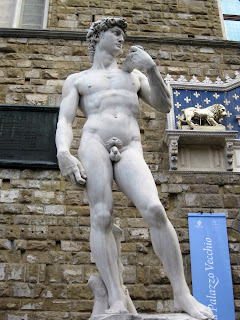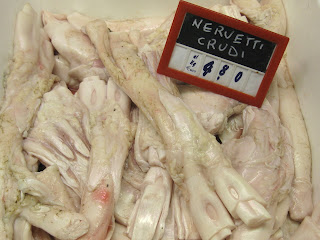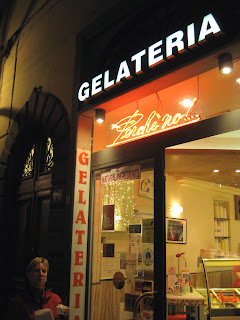After a watery week in Venice and two weeks traipsing around the Tuscan countryside we spent five nights in Florence. Do not, and I repeat, do not drive in Florence. We dropped the car off about two kilometers south of the city and took a taxi. What a thrill to across the Arno and plunge into the crowds of people lining the plazas and of course blocking the road. Didn’t seem to stress the taxi driver! Paul kept saying that this was the best decision of his trip. Here is our top ten, all reached by foot.
Uffizi
A marathon of early religious and then renaissance art awaits you in the forty-two room Galleria degli Uffizi. This gallery has the greatest collection of Italian painting anywhere with works from Botticelli, Leonardo da Vinci, Michelangelo, Giotto, Caravaggio and Titian. To prevent an all-day marathon reserve your tickets in advance otherwise you will be lining up for a couple hours like many of the day-trippers.
Ponte Vecchio - see my post on Famous Bridges.
Palazzo Vecchio and Piazza a Signoria
We didn’t visit this impressive palace opting for the Pitti Palace on the other side of the river Arno. The piazza in front of the palace is worth an hour to sit in the sun reading a book, people watching and for the women, enjoying all the naked men (statues).
 |
| Fake David |
 |
| Palazzo Vecchio |
Accademia
Once you have checked out the fake David in the Piazza a Signoria you can visit the real thing at the Galleria dell’Accademia. There are also numerous other Michelangelo statues and a very interesting display of painted chests (the wooden variety) the day we went.
Duomo
The area around Santa Maria del Fiore cathedral is animated with numerous historical landmarks including the Duomo itself with its magnificent dome by Brunelleschi, the campanile by Giotto and the Duomo Museum where you can see Michelangelo’s Pietà and Ghiberti’s Gates of Paradise if they’re not off being cleaned (happened to us). We had to muscle our way through the crowds to see the replicas on the Baptistery.
 |
| Duomo |
 |
| Gates of Paradise de Ghiberti |
 |
| La Pièta |
Campanile
Giotto’s campanile is 270 feet high (414 steps) and affords a great view over Brunelleschi’s Dome and the whole of Florence and the surrounding countryside. It’s best to go early in the morning to beat the crowds especially if you are claustrophobic.
 |
| Looking down the stairwell |
The Markets
You can buy some very inexpensive and stylish leather goods at the Mercato Centrale. Boy did we get lost trying to find this place! There are also indoor food markets where you buy a variety of spices, breads, pastries, fruits, vegetables and meats. You will note that Italians don’t waste any part of a cow or pig. Paul found it a stomach turning experience just taking a photo of some parts – raw nerves (not mine, a cow’s). Ick! I also read that you could buy tripe, a local delicacy, at roadside wagons much like our chip wagons in Ottawa or the pizza wagons in Nice. Fortunately we didn’t find any.
Mercato san Ambrogio was closer to home and much smaller than the central market. Nonetheless Marielle found a cute vest and we bought prepared food for our supper. We managed to draw attention to ourselves (again) while ordering some mouth-watering homemade apple pie. Nobody could speak English and our Italian came up short however a lady in the crowd intervened and even negotiated an extra slice for the price. I love Italians! Marielle also received extra servings of chicken and vegetables from the good looking chef at the takeout chicken place plus a handy canvas bag to transport it. She loves Italians!
Piazzale Michelangelo
On a rainy morning we hiked up the hill to this piazza. Great views await you as well as a short visit to the Basilica San Miniato al Monte. Here you can see sumptuous villas and olive groves with views of the Arno bridges, the Duomo and Santa Croce.
Pitti Palace
The imposing Pitti Palace is a few blocks south of Palazzo Vecchio over the Ponte Vecchio. The place and gardens are huge with several museums and gardens. We opted for a tour of the Palatine Gallery, Royal Apartments, and Modern Art Gallery. You cover a lot of territory. I just wish they would put more chairs in the rooms for foot weary husbands. We hadn’t completed our customary ten kilometers of walking so we went for a stroll through the Bobolo Gardens afterwards.
Bobolo Gardens
The gardens are built on a hillside affording wonderful views over the city. Hillside means exercise and if you weren’t tired after the Pitti Palace you will be after the Bobolo Gardens. And you haven’t walked home yet. Frequent water stops and a gelato break are highly recommended. The gardens are full of statues, fountains and trees (Ha! Ha!).



















































